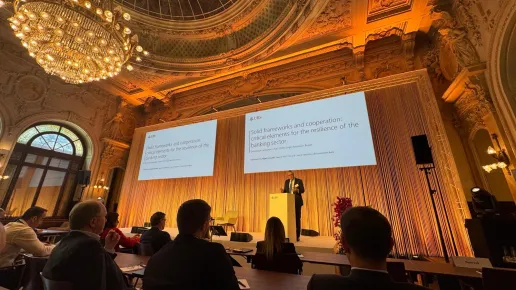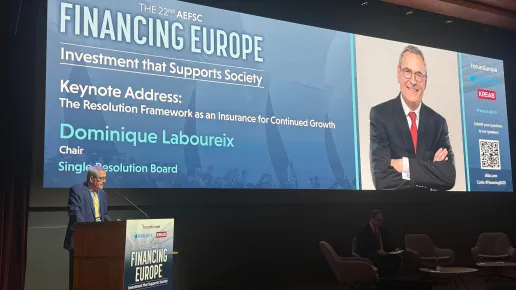[CHECK AGAINST DELIVERY]
[Introduction]
Bom dia Luís, Buongiorno Andrea, dear friends, good morning.
It is wonderful to be here in Lisbon once again. I hope to give you whistle-stop tour of some of the main issues we are working on, in close cooperation with all the National Resolution Authorities that make up the Single Resolution Mechanism. Of course, it goes without saying that we also work in collaboration with Andrea and his team at the Single Supervisory Mechanism and our common participation to this event shows that this cooperation is a daily reality .
This morning I’ll address several topics in my opening speech.
First, I want to look at recent events;
Second, I’ll share with you the SRB’s position on the European Commission’s Crisis Management and Deposit Insurance proposals, or CMDI as we call it in Brussels jargon;
Third, I’ll take a look at the progress being made on the build-up of MREL and resolvability, giving you a brief overview of the SRB’s recently published resolvability assessment and heat map;
Then, last but not least, I’ll give an indication of what the SRB is doing to better equip itself to handle any bumpy roads ahead in financial stability terms.
[Turmoil in the US and Switzerland]
Onto my first point then: the events in the US and Switzerland. For the SRB, it is still difficult to draw final lessons from these cases.
There are good elements and bad – among the good, resilience in the European banking sector. Among the warning signals: the speed of outflows: once confidence is lost, everything can collapse.
Among the key lessons for the future, is the need for flexibility as well as predictability; but also:
clear communication, to make us understood;
strong cooperation, to be ready whatever the situation is, and;
the need for more transfer tool strategies or combination of tools. This does not mean that the bail in tool is not usable but that we must consider crisis situation where the use of open bank bail-in strategy will not provide for any solution. As an example, a reputation risk can kill even the wealthiest bank.
I would also add that there is no need to change everything, or to use the English expression, we don’t need to throw the baby out with the bathwater – instead, we must close the gaps in the current framework.
Gaps such as:
Liquidity in resolution for banks and for tail risk;
Scope of resolution , here CMDI can provide for answers;
And making sure we have more Banking Union, not less.
Confidence is key – and trust is hard won. We have built up that trust over recent years in the Banking Union, thanks to the pillars of supervision and resolution.
Nevertheless, we must remain vigilant and diligently work to promote financial stability, because if trust is hard won, it is also easily lost.
[CMDI]
That takes me to my second point: CMDI.
With regard to the CMDI, the proposals are not perfect but they are a step in the right direction. I think here, we are very much in line with the ECB’s opinion on a range of issues.
The SRB, like the ECB, supports the expansion of resolution in parallel with a more realistic possibility of using DGS in resolution. To allow for that, the SRB, like the ECB, supports the removal of the DGS super priority, the single-tier depositor preference, the harmonisation of the LCT and so on.
This is because the CMDI goes some way towards strengthening the crisis management tool-set, particularly to enact sales or bridge banks, with a potential use of the DGS to bridge the gap to the 8%, if need be, to access the SRF – the Single Resolution Fund. Of course, I would like to have seen the CMDI go further, but let us not have perfect being the enemy of the good. Something important to note on this: one difficulty, or characteristic, of the proposal is that we cannot easily pick and choose what we want to keep and to remove the rest, since the whole proposal is interconnected.
We all know that there are controversies around these changes. However, the CMDI proposal is also made of degrees of other generally small and technical elements, not controversial, which can help authorities before, at the moment and after the crisis. Here my message is clear: even if you disagree on the funding of the resolution schemes, please agree on all the other measures suggested by the EU. Don’t throw the baby out with the bath water!
[Resolvability Assessment and Heat map]
As CMDI is not yet in place, the SRB must also work on implementing more resolvability under the current framework.
In that regard, despite recent turmoil, MREL continues to be built up. The SRB has decided to maintain its policy on MREL with minimal changes this year.
Last month the SRB published its second annual resolvability assessment and heat map report. The report takes stock of the progress made by banks in being considered resolvable, implementing the SRB Expectations for Banks and building up MREL, which are the minimum requirement for eligible liabilities and own funds.
The assessment shows that most banks have continued to make good progress: they have built-up financial resources to withstand severe financial shocks and are on track to meet their targets by the end of this year, which is a significant milestone on the road to financial stability.
Banks have significantly increased their loss-absorbing and recapitalisation resources, otherwise known as MREL capacity, to ensure that severe losses and recapitalisation needs are borne by shareholders and investors rather than by taxpayers. By the end of 2022, two-thirds of the banks had reached their final MREL target for 2024, including the Combined Buffer Requirement or CBR. As a result, the aggregate MREL shortfall across all SRB banks has decreased by one third compared to 2021, and now amounts to 0.3 percent of the total risk exposure amount also called the TREA (or more simply the risk weighted assets).
Banks have also further developed their operational processes and started testing their information systems to support the use of these funds in a crisis.
By the end of 2023, banks are expected to close the main remaining gaps, notably on liquidity and funding in resolution, separability and restructuring.
Then, the SRB will review whether material shortcomings remain and take remedial action where needed.
Looking ahead, given the evolving nature of the risks banks have to face, the resolvability assessment has to adapt in order to provide an adequate response to crisis events at any time.
Banks will need to provide evidence that they update their resolvability capabilities over time. They will be requested to regularly test their capabilities according to a multiannual work programme and to make the necessary adjustments in order to make sure their resolution strategies are flexible enough to respond to a range of crisis scenarios. To this end, the SRB will continue engaging with banks to further operationalise resolution strategies and tools, with particular reference to transfer tools, liquidity in resolution and restructuring.
Another important tool to enable resolvability is the Single Resolution Fund. This year, the fund is on track to reach 1% of covered deposits, €77.6 billion.
[SRB Strategy]
Let me finish with a few words on the strategic review of our operations. The strategy is in the making, with a lot of enthusiasm. We have had input and consultation from a wide variety of stakeholders and the aim is to ensure that the SRB becomes even more efficient and effective in its work. So, what are the next steps? Well, in the coming months, we will finalise our plan, called SRM: Vision 2028. This will be the basis of SRB’s work programmes for the years ahead, which are published annually. This new Vision 2028 will better-equip the SRM to deal with the various challenges, to ensure banks can be resolved so as to protect financial stability at no cost to the taxpayer.
[Conclusion]
Ladies and gentlemen, I might stop there. I know that Luis has some interesting questions for both Andrea and I, and I understand there may also be questions from some of you.
With that – obrigado – thank you – grazie – merci!
Contact our communications team
Recent news



Related news and press releases





